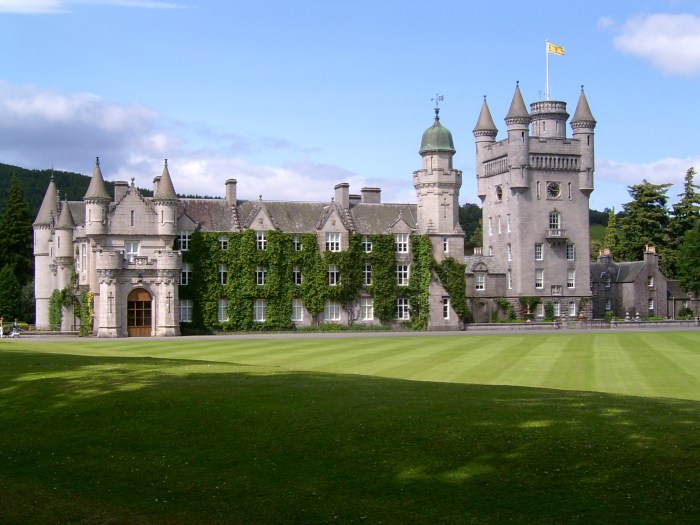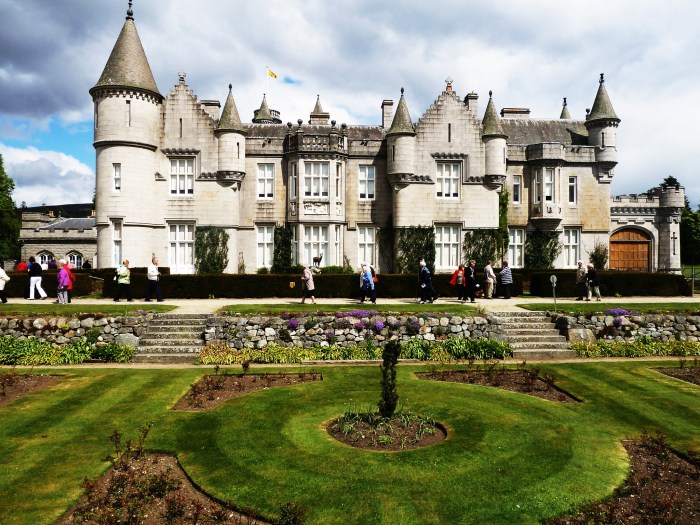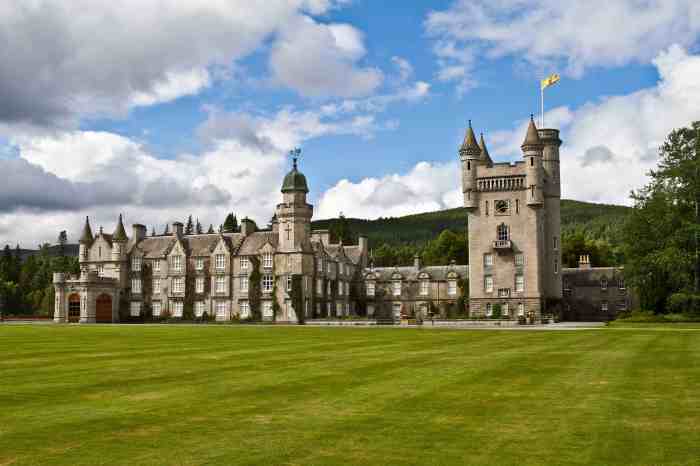Balmoral Castle, the beloved Scottish retreat of the British royal family, stands as a testament to history, architecture, and natural beauty. Nestled amidst the picturesque landscapes of Aberdeenshire, this grand castle has witnessed centuries of royal history and remains a cherished symbol of Scottish heritage.
From its humble beginnings as a hunting lodge to its transformation into a magnificent palace, Balmoral Castle has played a pivotal role in the lives of British monarchs. Queen Victoria and Prince Albert fell deeply in love with the castle and its surroundings, making it their summer residence and leaving an enduring legacy that continues to this day.
History and Significance of Balmoral Castle

Balmoral Castle, located in Aberdeenshire, Scotland, is a magnificent estate that has served as a cherished royal residence for centuries. Its history is deeply intertwined with the British monarchy and the Scottish Highlands, shaping its cultural and architectural significance.
Timeline of Construction and Ownership
- 1390: Sir William Drummond, Thane of Lennox, builds a hunting lodge on the site.
- 1451: King James II acquires the estate and constructs a royal castle.
- 1661: King Charles II grants Balmoral to the Earl of Middleton.
- 1762: The estate is sold to the Farquharson family.
- 1852: Queen Victoria and Prince Albert purchase Balmoral from the Farquharsons.
Historical Events and Figures
Balmoral Castle has witnessed significant historical events and has been associated with notable figures:
- Queen Victoria’s Highland Retreat: Queen Victoria fell deeply in love with Balmoral and made it her summer residence. She expanded the castle, redesigned the gardens, and established the estate as a center of outdoor recreation.
- Prince Albert’s Legacy: Prince Albert played a pivotal role in Balmoral’s development. He oversaw the castle’s expansion and modernization, transforming it into a comfortable and functional royal home.
- Royal Weddings and Events: Balmoral Castle has hosted numerous royal weddings and events, including the weddings of Queen Victoria’s children and the marriage of Queen Elizabeth II and Prince Philip.
Cultural and Architectural Significance, Balmoral castle
Balmoral Castle holds immense cultural and architectural significance:
- Scottish Baronial Style: The castle is a prime example of Scottish Baronial architecture, showcasing the distinctive turrets, towers, and battlements that define the style.
- Royal Heritage: As a royal residence, Balmoral Castle represents the continuity of the British monarchy and its deep connection to Scotland.
- Tourist Attraction: The castle and its grounds are open to the public during the summer months, attracting visitors from around the world who seek to experience its rich history and stunning surroundings.
Architecture and Design
Balmoral Castle is a magnificent example of Scottish Baronial architecture, a style that emerged in the 19th century and sought to revive the grandeur and aesthetics of medieval Scottish castles. The castle’s design is characterized by its asymmetrical towers, turrets, and gabled roofs, creating a picturesque and imposing appearance.
The construction of Balmoral Castle involved a combination of traditional and innovative techniques. The exterior walls are constructed from local granite, quarried from nearby Ballater. The interiors feature intricate wood carvings, decorative plasterwork, and hand-painted ceilings. The castle’s layout is functional and reflects the needs of a royal residence. The ground floor houses the public rooms, including the drawing room, dining room, and library. The upper floors contain the private apartments of the royal family, including bedrooms, dressing rooms, and sitting rooms.
Materials and Techniques
The use of local granite in the castle’s construction not only provided durability but also gave it a distinctive appearance. The granite blocks were carefully cut and fitted together, creating a solid and weather-resistant exterior. The interiors of the castle are adorned with a variety of materials, including oak, pine, and mahogany. The wood carvings and plasterwork were executed by skilled craftsmen, adding to the castle’s opulent and refined ambiance.
Layout and Purpose
The layout of Balmoral Castle is carefully designed to accommodate the needs of a royal residence. The public rooms on the ground floor are spacious and grand, providing ample space for entertaining guests and hosting official functions. The private apartments on the upper floors are more intimate and secluded, offering privacy and comfort to the royal family. Each room within the castle serves a specific purpose, from the grand dining room to the cozy sitting rooms, reflecting the diverse needs of its occupants.
Royal Residence and Retreat

Balmoral Castle holds a prominent position as a cherished royal residence for the British monarch. The castle’s secluded location amidst the picturesque Scottish Highlands offers a tranquil escape from the demands of public life. Queen Victoria and Prince Albert acquired the estate in 1852 and transformed it into their beloved summer retreat. Since then, the castle has been passed down through generations of the royal family, becoming an integral part of their private lives.
A Sanctuary for the Royal Family
Balmoral Castle provides a sanctuary where the royal family can unwind and connect with nature. The sprawling grounds, teeming with wildlife and verdant landscapes, invite leisurely walks, picnics, and outdoor pursuits. The castle’s interior is equally inviting, adorned with cozy sitting rooms, a grand ballroom, and a private chapel. It is here that the royals find respite from the rigors of their official duties, immersing themselves in family traditions and pursuing personal interests.
Memorable Moments and Anecdotes
Balmoral Castle has witnessed countless memorable moments in the lives of the British royal family. Queen Victoria’s deep affection for the estate is evident in her extensive diaries, which document her joyful time spent there. The castle also played a pivotal role in the courtship of Prince Charles and Princess Diana, who honeymooned at Balmoral in 1981. In recent years, the castle has been a favorite destination for Queen Elizabeth II, who often spends her summer holidays there, surrounded by her family and beloved dogs.
Gardens and Grounds: Balmoral Castle

Balmoral Castle boasts extensive gardens and grounds that span over 50,000 acres. These meticulously landscaped spaces contribute significantly to the castle’s grandeur and provide a sanctuary for recreation and relaxation.
Balmoral Castle, the Scottish royal family’s summer retreat, is a stunning estate nestled amidst the picturesque Cairngorms National Park. Its grandeur and history evoke a sense of timeless elegance. While Balmoral exudes a distinctly Scottish charm, it’s interesting to note that the region of bariloche in Argentina boasts a similar allure.
Located in the foothills of the Andes, bariloche offers breathtaking landscapes, adventure activities, and a blend of European and Patagonian influences. Despite the geographical distance, both Balmoral Castle and bariloche share a captivating ambiance that invites visitors to immerse themselves in their rich heritage and natural beauty.
The gardens are designed in a picturesque style, with winding paths, manicured lawns, and vibrant flowerbeds. Notable features include the Walled Garden, a Victorian-era masterpiece with glasshouses and exotic plants, and the Sunken Garden, a tranquil oasis adorned with fountains and sculptures.
Balmoral Castle, the cherished Scottish residence of the British royal family, stands amidst breathtaking landscapes. Its grand architecture and historical significance have captivated visitors for centuries. While exploring the castle’s grandeur, one may be inspired to venture further afield, discovering the enchanting city of Bergamo in Italy.
This medieval gem, nestled amidst the foothills of the Alps, boasts a rich cultural heritage and stunning architecture, offering a delightful contrast to the rugged beauty of Balmoral.
Arboretum
The arboretum is home to a vast collection of trees and shrubs from around the world. The trees, some of which are centuries old, create a serene and picturesque setting for walks and contemplation.
Balmoral Castle, the Scottish residence of the British royal family, is a magnificent estate nestled amidst breathtaking scenery. While it’s a popular destination for tourists, those seeking a tropical escape may find solace in Bacalar, Mexico. This stunning lagoon boasts crystal-clear waters and vibrant colors that rival the Scottish Highlands.
Yet, upon returning to Balmoral Castle, one can’t help but appreciate its timeless charm and the rich history it holds.
Estate Grounds
The estate grounds encompass a diverse range of landscapes, including forests, glens, and moorlands. These areas offer opportunities for hunting, fishing, and other outdoor pursuits. The River Dee, which flows through the estate, provides excellent salmon fishing.
Tourism and Accessibility

Balmoral Castle offers guided tours to the public, providing an exclusive glimpse into the private residence of the British royal family. These tours showcase the castle’s grand state rooms, offering insights into its rich history and significance.
To preserve and protect the castle for future generations, stringent measures are in place. Visitor numbers are carefully managed to minimize wear and tear, and conservation efforts are continuously undertaken to maintain the castle’s architectural integrity.
Public Access
Public access to Balmoral Castle is restricted to certain areas during the summer months. Visitors can explore the castle gardens, wander through the picturesque grounds, and admire the stunning views of the surrounding countryside.
Economic and Cultural Impact
Tourism plays a vital role in the local economy, providing employment opportunities and supporting businesses in the surrounding area. The castle’s cultural significance attracts visitors from around the world, promoting the region’s rich heritage and fostering appreciation for Scotland’s history and traditions.
Cultural Legacy and Impact
Balmoral Castle holds immense cultural significance in Scottish history and folklore. Its enduring presence in literature, art, and film has shaped perceptions of Scottish identity and heritage.
Literary Significance
Balmoral Castle has been a source of inspiration for numerous literary works. Poets such as William Wordsworth and Robert Burns have penned verses capturing the castle’s beauty and grandeur. The castle’s royal associations have also made it a backdrop for historical novels, including those by Sir Walter Scott and Catherine Cookson.
Artistic Inspiration
Balmoral Castle has served as a muse for renowned artists. Its picturesque architecture and surrounding landscapes have been depicted in paintings by J.M.W. Turner and Edwin Landseer. The castle’s iconic silhouette has also been captured in photographs, contributing to its enduring visual legacy.
National Heritage
Balmoral Castle is deeply intertwined with Scottish national identity. Its connection to the British monarchy has strengthened its symbolic importance as a representation of Scottish heritage. The castle’s annual Braemar Gathering, a traditional Highland Games event, further reinforces its cultural significance.
Conclusion

Balmoral Castle stands as a testament to the enduring spirit of the British monarchy and the deep connection between the royal family and Scotland. Its rich history, stunning architecture, and breathtaking surroundings make it a beloved destination for visitors from around the world. As the royal family continues to cherish Balmoral as their private retreat, it remains a symbol of tradition, continuity, and the enduring allure of the Scottish Highlands.
Commonly Asked Questions
When was Balmoral Castle built?
The original castle was built in 1390, with significant additions and renovations made in the 19th century.
Who owns Balmoral Castle?
Balmoral Castle is privately owned by the British monarch and is not part of the Crown Estate.
Is Balmoral Castle open to the public?
Yes, the castle and its gardens are open to the public during certain times of the year.